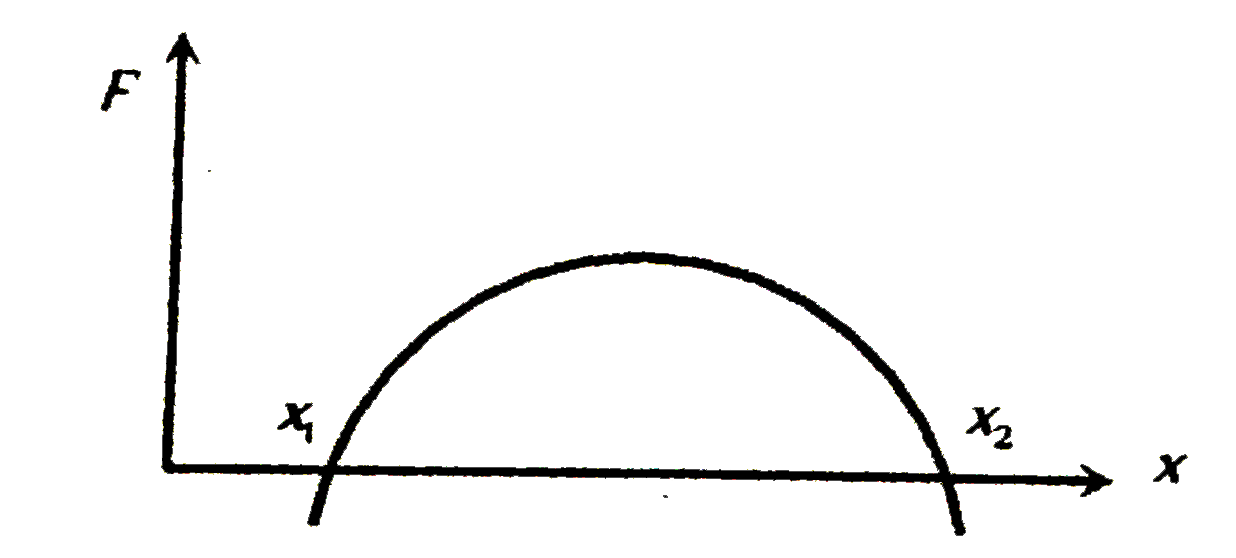If a particle moves in a potential energy held U=U0−ax+bx2, where are a and b particle constants obtain an expression for the force acting on if as a function of position. At what point does the force vanish? Is this a point of stable equilibrium ?
Calculate the force constant and frequency of the particle.
F=−dUdx=a−2bx
F=0,atx=a/2b
If stable equilibrum is present at this position, (d2Udx2>0)
Hence, (d2Udx2=2b>0)
i.e., x=a2b is a point of minimum potential energy
Hence, the equilibrium is stable. The partical will oscillate about x=a2b
The effective force constant of oscillation
Keff=(d2Udx2∣x=a2b)=2b
As Keff=momeg2=2b=momeg2
or ω2=2bm⇒ω=2πf=√2bm⇒f=12π√km
Topper's Solved these Questions
- LINEAR AND ANGULAR SIMPLE HARMONIC MOTIONBOOK - CENGAGE PHYSICSCHAPTER - LINEAR AND ANGULAR SIMPLE HARMONIC MOTIONEXERCISE - Solved Example
15 Videos
- LINEAR AND ANGULAR SIMPLE HARMONIC MOTIONBOOK - CENGAGE PHYSICSCHAPTER - LINEAR AND ANGULAR SIMPLE HARMONIC MOTIONEXERCISE - Exercise 4.1
23 Videos
- KINETIC THEORY OF GASES AND FIRST LAW OF THERMODYNAMICSBOOK - CENGAGE PHYSICSCHAPTER - KINETIC THEORY OF GASES AND FIRST LAW OF THERMODYNAMICSEXERCISE - Interger
11 Videos
- MISCELLANEOUS KINEMATICSBOOK - CENGAGE PHYSICSCHAPTER - MISCELLANEOUS KINEMATICSEXERCISE - Interger type
3 Videos
Similar Questions
If a particle moves in a potential energy held U=U0−ax+bx2, where are a and b particle constants obtain an expression for the force acting on if as a function of position. At what point does the force vanish? Is this a point of stable equilibrium ?
Calculate the force constant and frequency of the particle.
View SolutionIf a particle of mass m moves in a potential energy field U=U0−ax+bx2 where U0, a and b are positive constants.Then natural frequency of small oscillations of this particle about stable equilibrium point is 1xπ√bm. The value of x is?
View Solution
Knowledge Check
The force acting on a body moving along x-axis varies with the position of the particle shown in the figure. The body is in stable equilibrium at
 . Ax=x1Bx=x2Cboth x1 and x2Dneither x1 nor x2
. Ax=x1Bx=x2Cboth x1 and x2Dneither x1 nor x2A particle of mass m oscillates with a potential energy U=U0+αx2, where U0 and α are constants and x is the displacement of particle from equilibrium position. The time period of oscillation is
A2π√mαB2π√m2αCπ√2mαD2π√mα2The force acting on a body moving along x -axis varies with the position of the particle as shown in the fig. The body is in stable equilibrium at.
 Ax=x1Bx=x2Cboth x1 and x2Dneither x1 nor x2
Ax=x1Bx=x2Cboth x1 and x2Dneither x1 nor x2
A particle of mass m moves in a one dimensional potential energy U(x)=−ax2+bx4, where a and b are positive constant. The angular frequency of small oscillation about the minima of the potential energy is equal to
View SolutionThe potential energy U=3ax3−2bx2. The force constant is represented by
View SolutionA particle of mass m moving along x-axis has a potential energy U(x)=a+bx2 where a and b are positive constant. It will execute simple harmonic motion with a frequency determined by the value of
View SolutionFor a particle moving on a curved path kinectic energy is given as k=AS where S is distance moved and A is constant quantity .Net force acting on particle is
View SolutionA particle free to move along x-axis is acted upon by a force F=−ax+bx2whrteaandbarepositiveconstants.For ximplies0, the correct variation of potential energy function U(x) is best represented by.
View Solution
